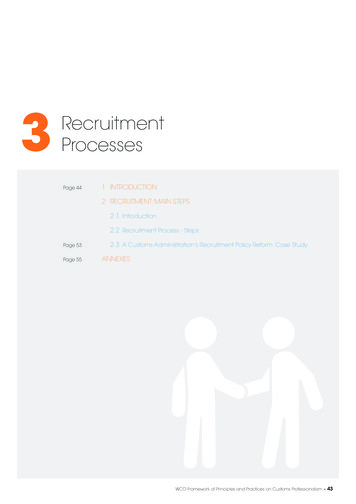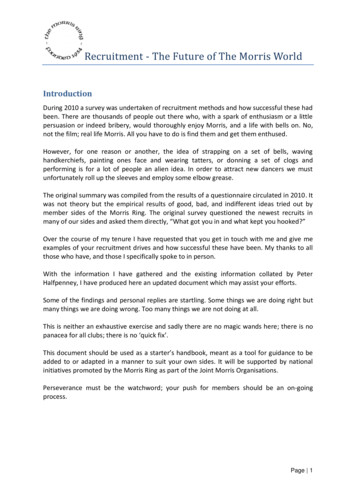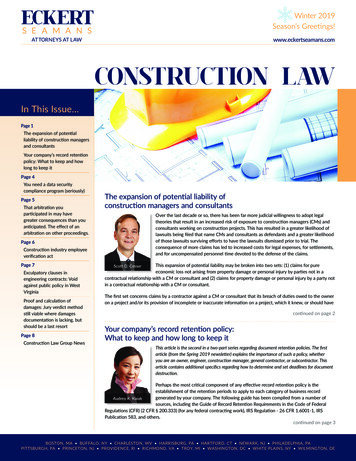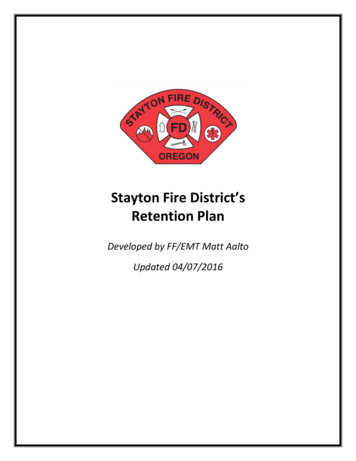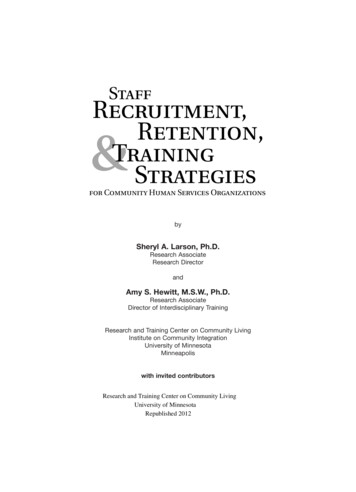
Transcription
StaffRecruitment,Retention,TrainingStrategies&for Community Human Services OrganizationsbySheryl A. Larson, Ph.D.Research AssociateResearch DirectorandAmy S. Hewitt, M.S.W., Ph.D.Research AssociateDirector of Interdisciplinary TrainingResearch and Training Center on Community LivingInstitute on Community IntegrationUniversity of MinnesotaMinneapoliswith invited contributorsResearch and Training Center on Community LivingUniversity of MinnesotaRepublished 2012
CONTENTSAbout the Authors . . . . . . . . . . . . . . . . . . . . . . . . . . . . . . . . . . . . . . . . . . . . . . . . . . . .viiAbout the Contributors . . . . . . . . . . . . . . . . . . . . . . . . . . . . . . . . . . . . . . . . . . . . . . . .ixForewordK. Charlie Lakin . . . . . . . . . . . . . . . . . . . . . . . . . . . . . . . . . . . . . . . . . . .xiAcknowledgments . . . . . . . . . . . . . . . . . . . . . . . . . . . . . . . . . . . . . . . . . . . . . . . . . . . .xixIntroduction . . . . . . . . . . . . . . . . . . . . . . . . . . . . . . . . . . . . . . . . . . . . . . . . . . . . . . .xxiii1Recruitment, Retention, and Training Challenges in CommunityHuman Services: A Review of the Literature . . . . . . . . . . . . . . . . . . . . . . . . . . .1Sheryl A. Larson, Amy S. Hewitt, and Beth A. KnoblauchIFinding and Hiring Employees2Recruiting Direct Support Professionals . . . . . . . . . . . . . . . . . . . . . . . . . . . . . .21Sheryl A. Larson and Amy S. Hewitt3What Is This Job All About? Using Realistic Job Previews in theHiring Process . . . . . . . . . . . . . . . . . . . . . . . . . . . . . . . . . . . . . . . . . . . . . . . . . .47Sheryl A. Larson, Susan N. O’Nell, and John K. Sauer4Selection Strategies . . . . . . . . . . . . . . . . . . . . . . . . . . . . . . . . . . . . . . . . . . . . . .75Sheryl A. Larson and Amy S. HewittIISocializing and Training Employees5Orientation, Socialization, Networking, and Professionalization . . . . . . . . .105Amy S. Hewitt, Sheryl A. Larson, Susan N. O’Nell,and John K. Sauer6Linking Training and Performance Through Competency-BasedTraining . . . . . . . . . . . . . . . . . . . . . . . . . . . . . . . . . . . . . . . . . . . . . . . . . . . . . .125Susan N. O’Nell and Amy S. Hewitt7Out of the Classroom and On to Employee Training Programsthat Work . . . . . . . . . . . . . . . . . . . . . . . . . . . . . . . . . . . . . . . . . . . . . . . . . . . . .153Susan N. O’Nell, Amy S. Hewitt, and John K. Sauer8Fostering Commitment and Skill Through Mentoring Programs . . . . . . . . .177Amy S. Hewitt, Traci L. LaLiberte, Jody Kougl-Lindstrom,and Sheryl A. LarsonIIIMotivating and Supporting Employees9Staff Motivation and Recognition . . . . . . . . . . . . . . . . . . . . . . . . . . . . . . . . . .197Traci L. LaLiberte, Amy S. Hewitt, and Sheryl A. Larson10From Grumbling to Getting Along: Creating and Using Teamsto Enhance Retention . . . . . . . . . . . . . . . . . . . . . . . . . . . . . . . . . . . . . . . . . . . .215Amy S. Hewitt, John K. Sauer, and Lori Sedlezkyv
vi 11Supporting and Training Supervisors . . . . . . . . . . . . . . . . . . . . . . . . . . . . . . .239Amy S. Hewitt and Sheryl A. LarsonIVAssessing Problems and Designing Solutions12Creating Organizational Change Initiatives . . . . . . . . . . . . . . . . . . . . . . . . . .271Elizabeth Lightfoot, Amy S. Hewitt, and John K. Sauer13Assessing and Evaluating Workforce Challenges . . . . . . . . . . . . . . . . . . . . . .287Sheryl A. Larson, Traci L. LaLiberte, and Patricia Salmi14Selecting and Implementing Strategies for Change . . . . . . . . . . . . . . . . . . . .321Sheryl A. Larson, Lynda Anderson, and Amy S. HewittVThe Bigger Picture15Strategies for Policy Change . . . . . . . . . . . . . . . . . . . . . . . . . . . . . . . . . . . . . .343Sheryl A. Larson and Amy S. HewittContentsReferences . . . . . . . . . . . . . . . . . . . . . . . . . . . . . . . . . . . . . . . . . . . . . . . . . . . . . . . . .363Index . . . . . . . . . . . . . . . . . . . . . . . . . . . . . . . . . . . . . . . . . . . . . . . . . . . . . . . . . . . . .377
ABOUT THE AUTHORSSheryl A. Larson, Ph.D., Research Associate and Research Director, University ofMinnesota, Institute on Community Integration, Research and Training Center onCommunity Living, 214B Pattee Hall, 150 Pillsbury Drive SE, Minneapolis, MN 55455Sheryl A. Larson has 23 years of experience in providing services to individuals withintellectual or developmental disabilities as a residential counselor, behavior analyst,program evaluator, consultant, personal advocate and researcher. She earned a B.A. inpsychology and elementary education from Bethel College in St. Paul, Minnesota, andan M.A. and Ph.D. in educational psychology from the University of Minnesota, College of Education and Human Development. Her dissertation examined factors associated with turnover in small group home settings. She is Research Director and aprincipal investigator at the Research and Training Center on Community Living,where she has worked since 1987, directing projects involving survey and interventionresearch, secondary analysis of large data sets, and research synthesis on residentialservices, personnel issues, disability statistics, and community integration for individuals with intellectual or developmental disabilities. Dr. Larson has authored or coauthored more than 100 publications on those topics. Recent books include UsingSurvey Data to Study Disability: Results from the National Health Survey on Disability, coedited with B.M. Altman, S.N. Barnartt, and G.E. Hendershot (Elsevier JAI, 2003), andStaff Recruitment and Retention: Study Results and Intervention Strategies, co-authoredwith K.C. Lakin and R.H. Bruininks (American Association on Mental Retardation[AAMR], 1998).Dr. Larson currently directs two National Institute on Disability and Rehabilitation Research (NIDRR) field-initiated projects, including one to create a nationaltechnical assistance model to support front-line supervisors and another to conductanalyses using the National Health Interview Survey to describe characteristics of andoutcomes for people with disabilities living in their own or family homes. She hasworked with her colleagues at the University of Minnesota to develop statewide workforce plans and to provide technical assistance on workforce issues to providers andfamilies in several states. She has made more than 150 presentations at national, state,regional, and local conferences and workshops, including workshops on staff recruitment and retention for more than 3,000 managers and supervisors. She is an AAMRFellow, President of the AAMR Community Services Division, a consulting editor ofMental Retardation and Journal of Intellectual and Developmental Disability and has participated in NIDRR and Centers for Disease Control and Prevention grant reviewpanels. She received a Presidential Award from AAMR for workforce research. Sheserves on the Minnesota Governor’s Council on Developmental Disabilities as the highereducation representative and is on the Board of Directors of No Place Like Home, aprogram providing supportive housing to adults with disabilities.vii
viii About the AuthorsAmy S. Hewitt, M.S.W., Ph.D., Research Associate and Director of InterdisciplinaryTraining, University of Minnesota, Institute on Community Integration, Researchand Training Center on Community Living, 214D Pattee Hall, 150 Pillsbury DriveSE, Minneapolis, MN 55455Amy S. Hewitt has an extensive background and work history in the field of developmental disabilities and has worked in various positions over the past 23 years, includingas a residential Program Director and Director of Training. She is currently ResearchAssociate and Director of Interdisciplinary Training at the University of Minnesota,Institute on Community Integration, where she directs several federal and state research, evaluation, and demonstration projects in the areas of direct support professional (DSP) workforce development and community human services for people withdisabilities. Dr. Hewitt is a national leader in the area of workforce development andcommunity supports for individuals with developmental disabilities.Dr. Hewitt’s current projects include the College of Direct Support, a nationaltraining curriculum development project that currently offers training to more than100,000 DSPs throughout the United States; Mobilizing for Change, an Administrationon Developmental Disabilities field-initiated project to develop an on-line trainingcurriculum for frontline supervisors (College of Frontline Supervision); Removingthe Revolving Door, a national project to develop and implement a train-the-trainertechnical assistance model in five states to teach others how to effectively work withorganizations to reduce DSP turnover and vacancy rates; Kansans Mobilizing forWorkforce Change, a systems change project to improve retention and recruitment ofDSPs in community human services organizations; and The Illinois ComprehensiveWorkforce Development Initiative to Achieve Improved Individual Outcomes forCitizens with Intellectual and Developmental Disabilities, a statewide systems changeproject to reduce direct support professional turnover.Dr. Hewitt has authored and co-authored many curricula, journal articles, andmanuscripts. She is a managing editor of Frontline Initiative, a national newsletter forDSPs; a contributing editor for LINKS, a newsletter of ANCOR; and guest editor ofMental Retardation, a journal of the American Association on Mental Retardation(AAMR). She is currently a board member for Arc Hennepin-Carver and for Friendship Ventures. She is a founding member and past Co-chair of the National Alliancefor Direct Support Professionals and a past board member of the AAMR.
ABOUT THE CONTRIBUTORSLynda Anderson, M.A., M.P.H., is a doctoral candidate at the University of Minnesota. She has more than 20 years of experience in the field of developmental disabilities. She has worked as a program director, service coordinator, advocate, and policyplanner and in other related capacities in the field of developmental disabilities. Shewas a graduate student at the Institute on Community Integration.Beth A. Knoblauch, M.A., lives in Minneapolis, Minnesota, with her family. She wasa graduate student at the Institute on Community Integration. She co-authored theCollege of Direct Support curriculum and supported work in the area of direct support professional workforce development.Jody Kougl-Lindstrom, M.S.W., Adult Developmental Disabilities Unit Supervisor,Ramsey County Human Services Department, 160 E. Kellogg Boulevard, 7th Floor,St. Paul, MN 55101Jody has worked in the field of helping with people with disabilities in various capacitiesfor more than 11 years, including as a direct support professional, job coach/counselor,and service coordinator. She is a supervisor of service coordinators for people with developmental disabilities in Ramsey County, Minnesota. Ms. Kougl-Lindstrom was agraduate student at the Institute on Community Integration.Traci L. LaLiberte, M.S.W., B.S., Doctoral Candidate, University of MinnesotaSchool of Social Work, 1404 Gortner Avenue, St. Paul, MN 55108Traci L. LaLiberte is a doctoral candidate at the University of Minnesota, where shespecializes in child welfare and disability studies. She has been an active professionalin the fields of child welfare and developmental disabilities since the early 1990s.Ms. LaLiberte is the 2003 recipient of the Mary A. McEvoy Award for Public Engagement and Leadership. Ms. LaLiberte facilitates training seminars for front-linesupervisors in the field of developmental disabilities nationwide and has also developed curricula for the College of Direct Support.Elizabeth Lightfoot, Ph.D., M.S.W., Assistant Professor of Social Work, Universityof Minnesota, 105 Peters Hall, 1404 Gortner Ave, St. Paul, MN 55108Elizabeth Lightfoot is Assistant Professor of Social Work at the University ofMinnesota, and she is also affiliated with the University of Minnesota’s Institute onCommunity Integration. Dr. Lightfoot received her Ph.D. in public policy from Indiana University and M.S.W. from the University of Minnesota. Her research has focused on the politics and implementation of disability antidiscrimination policy, andshe is exploring the intersection between aging and disability policy issues.ix
x About the ContributorsSusan N. O’Nell, Project Coordinator, University of Minnesota, Institute on Community Integration (ICI), Research and Training Center on Community Living, 210BPattee Hall, 150 Pillsbury Drive SE, Minneapolis, MN 55455Susan N. O’Nell has worked at the ICI since 1995, with a focus on workforce development and training of direct support professionals and front-line supervisors. Ms. O’Nellhas developed several training curricula in both traditional and multimedia formats.She coordinates the instructional design and development of the on-line curriculumfor the College of Direct Support and the College of Frontline Supervision. Prior toworking at the ICI, Ms. O’Nell worked for 12 years as a direct support professionalsupporting people with developmental disabilities.Patricia Salmi, M.S., Doctoral Candidate and Design Specialist, Department of Design, Housing, & Apparel, University of Minnesota, 240 McNeal Hall, 1985 BufordAvenue, St. Paul, MN 55108Patricia Salmi is a physical environments design professional who specializes in accessibility issues for persons with intellectual disabilities (ID). Pat has taught special education and has worked as a design professional for more than 20 years. She is currentlyenrolled in a doctoral program with an emphasis in accessibility in the built environment for individuals with ID. Pat is the 2003 winner of the ASID (American Societyof Interior Designers) Education Foundation/Joel Polsky Academic AchievementAward for her master’s thesis, An Exploration of Critical Factors for Accessibility and Wayfinding for Adults with Mental Retardation.John K. Sauer, M.S.W., M.Ed., Program Coordinator, University of Minnesota, Institute on Community Integration (ICI), 150 Pillsbury Drive SE, Minneapolis, MN55455John K. Sauer is Program Coordinator at the ICI and is intensely involved in the lifeof his sister, who has mental retardation. His experience in supporting his sister tomove from an institution, where she had lived for most of her life, to a communitysupported living program and his efforts to ensure that she receives person-centeredsupports have given him critical insight into the need for a competent and stable direct support professional workforce. He has 35 years of experience working in humanservices as a social worker, policy and program developer, administrator, educator,human resources development manager, trainer, and organizational change consultantat the local, state, and national levels and for nonprofit, corporate, educational, andgovernmental agencies.Lori Sedlezky, M.S.W., is an independent consultant offering services in programdesign and evaluation, curriculum development, and staff training to human servicesorganizations. Previously, she worked as director of programs and services at ArcHennepin-Carver; project coordinator at the Institute on Community Integration,University of Minnesota; and program manager for community-based vocational andresidential services. She received her master’s degree in social work and bachelor’s degree in psychology from the University of Minnesota.
FOREWORDIn 1980 my colleagues and I at the University of Minnesota completed the first national study of turnover among people providing direct support to individuals withdevelopmental disabilities. In that study we examined rates of job staying and job leaving and associated individual and organizational factors in community and institutional settings. Thinking back on that research, it is in some ways difficult to comprehend how substantially the system of support for individuals with developmentaldisabilities has changed. Today the number of individuals with developmental disabilities living in state institutions is about one quarter of the number of 25 years ago.Eight times as many people with developmental disabilities receive residential supportin community settings as 25 years ago. Then there was an average of 20 people perresidential setting; today there is an average of 3. The idea of supporting people withdevelopmental disabilities within their family home was then little more than an idealistic dream; today it is a key component of almost all state service systems, now assisting more than 400,000 families (Prouty, Smith, & Lakin, 2003). These changeshave been evident in varying degrees in all state systems of long-term services and supports (LTSS), and in important ways these changes have transformed the lives andopportunities of hundreds of thousands of individuals with developmental disabilities.Yet, important aspects of LTSS remain as they were 25 years ago. One of the most constant and important of these aspects remains, to use the words of Secretary of LaborElaine Chao (2002), that direct support professionals (DSPs) are “the cornerstone ofAmerica’s long-term care system” and that the nation’s “fundamental, long-term challenge [in supporting people with developmental disabilities] is to develop a committed, stable pool of workers who are willing and able to provide quality care.”There are other ways in which the circumstances of DSPs today are much as theywere a quarter of a century ago. We wrote then, as we still believe, “That the startingwage paid for this [direct support] work is often comparable to what high school students make wrapping hamburgers is a national disgrace” (Lakin & Bruininks, 1981b,p. 168). Sadly, the same is true today. Recently, we noted that the average wage ofDSPs in 2000 was 55% of the average for all workers covered by unemployment insurance and that the average beginning wage for DSPs in community human servicessettings ( 15,247 annually) was essentially equal to the poverty level for a family ofthree ( 14,630) (Lakin, Polister, & Prouty, 2003).There are other similarities between what we observed 25 years ago and what wesee today. In our studies 25 years ago, we estimated a national turnover rate of 54%among DSPs employed in private residential settings. Today turnover rates amongDSPs in private community residential settings are consistently within the 40%–70%range (see Chapter 1 for a review of these studies). Twenty-five years ago we estimateda turnover rate of 33% among DSPs employed in state institutions, essentially equalto the 28% national average for all state institutions in 2002 (Larson, Coucouvanis, &xi
xii ForewordProuty, 2003). The primary factors we reported to be associated with people stayingin (as opposed to quitting) direct support jobs 25 years ago were pretty much the sameas those identified in research today: having relatively higher amounts of and/or satisfaction with compensation (pay and benefits), sensing that one’s job fits within a career path, having satisfying relationships with co-workers and supervisors, having goodcommunication within the organization, sensing that one’s judgment and expertise arerecognized and trusted, feeling that one’s skills are being developed and used, considering one’s job interesting and rewarding, feeling that one’s job fulfills one’s initialexpectations for it, feeling that one’s work is valued, and so forth (Lakin & Bruininks,1981a, 1981b; Lakin, Bruininks, Hill, & Hauber, 1982; Lakin, Hill, Bruininks, Hauber,& Krantz, 1983).Certain important changes have occurred with regard to understanding and responding to the challenge of providing the “committed, stable pool of workers” thatSecretary Chao rightfully recognized is the most essential component of our nationalsystem of LTSS. Today, much more than 25 years ago, the struggle to provide this poolof workers is viewed as significant within the national policy agenda. For example, inthe Developmental Disabilities Assistance and Bill of Rights Act of 2000 (PL 106-402),Congress observed that “as increasing numbers of individuals with developmental disabilities are living, learning, working and participating in all aspects of communitylife, there is an increasing need for a well-trained workforce that is able to provide theservices, supports, and other forms of direct assistance required to enable the individuals to carry out those activities” (42 U.S.C. § 150001 [a][14]).One primary cause of increased attention to the DSP workforce within the national policy arena has been the elevation of community LTSS to the level of nationalcommitment. A substantial body of successful experience and documented benefits, agrowing appreciation of basic human rights, and other factors have provided important foundations for a national commitment to ensuring people with developmentaldisabilities a place in the communities of their birth or choice. These foundations weregreatly solidified in the passage of the Americans with Disabilities Act (ADA) of 1990(PL 101-336), its interpretation by the U.S. Supreme Court in Olmstead v. L.C., and thesubsequent commitment of the Bush Administration to fully accept, enforce, and contribute to the commitments of the ADA and Olmstead through an interdepartmentalcampaign known as the New Freedom Initiative.In Olmstead the U.S. Supreme Court ruled that Title II of the ADA clearly, legally,and enforceably requires states to provide the services, programs, and activities developed for individuals with disabilities in the “most integrated setting appropriate.” TheSupreme Court concluded specifically that states were obligated to place qualifiedindividuals with disabilities in community settings, rather than in institutions, whentreatment professionals determined that a community placement was appropriate;when the individuals themselves did not oppose an appropriate community placement;and when the state in which the person lived could reasonably accommodate the community placement, taking into account the resources available and the needs of otherswith disabilities. Two years after the Olmstead decision, President Bush signed an Executive Order in June 2001, referred to as the New Freedom Initiative, that stipulated
Foreword xiiithat “the United States is committed to community-based alternatives for individualswith disabilities and recognizes that such services advance the best interests of Americans” and that requested assistance from federal agencies in the fulfillment of thatcommitment.So, one principal reason that the DSP workforce is an object of national attentionis that it is national policy that people with disabilities be provided with appropriatecommunity supports. While the government can promise appropriate communitysupports, it cannot provide them without the “committed, stable pool of workers” referred to by Secretary Chao. A primary challenge in fulfilling the national commitment to providing people with community supports is recruiting, training, and retaining sufficient numbers of DSPs to do so. The growing difficulties and frequentfailures in meeting this challenge have reached the stage of national crisis. In 2003 thiscrisis was recognized in concurrent resolutions of the U.S. Senate and U.S. House ofRepresentatives. Referred to as the Direct Support Professional Recognition Resolution, each resolution expressed the findings of the Congress that “private providersand the individuals for whom they provide supports and services are in jeopardy as aresult of the growing crisis in recruiting and retaining a direct support workforce”(H. Con. Res. 94, 2003; S. Con. Res. 21, 2003). The resolutions found that “this workforce shortage is the most significant barrier to implementing the Olmstead decisionand undermines the expansion of community integration as called for by PresidentBush’s New Freedom Initiative, placing the community support infrastructure atrisk.” The resolutions concluded,It is the sense of the Congress that the Federal Government and States should make it apriority to ensure a stable, quality direct support workforce for individuals with mentalretardation or other developmental disabilities that advances our Nation’s commitmentto community integration for such individuals and to personal security for them and theirfamilies.To be sure, we have a national crisis in providing sufficient numbers of qualifiedDSPs to meet the needs of individuals with developmental disabilities. Consideringresidential services alone, including data on service recipients in 2003, average staffingratios from national and state studies, statistics on ratios of full-time to part-time employees, and DSP turnover rates that average about 50% per year, it is estimated thatabout 350,000 new DSPs were hired to provide residential supports for individualswith developmental disabilities in 2003. What is most notable about that number, inaddition to its size, is that an estimated 94% of that total was made up of people hiredto replace DSPs who left existing positions, while only about 6% were people hiredfor newly developed community supports positions. The ability to meet the currentLTSS system’s appetite for new employees has in many areas reached the point of nonsustainability. This is increasingly evident in the substantial and growing numbers ofposition vacancies reported by individual service providers and in state studies. Effortsto recruit more and more people into work situations in which most will leave in theirfirst year is increasingly debilitating to organizations and, furthermore, devastating tothe people with disabilities who experience nonstop withdrawal of people upon whomthey depend to know, understand and help them.
xiv ForewordPresent circumstances promise little in the way of notable improvement in the national crisis in the DSP supply in the foreseeable future. Although a generally poor jobmarket can play a significant role in increasing recruitment and tenure of DSPs during the short term, demographic factors continue to suggest long-term difficulties inproviding a sufficient DSP workforce if past practices are relied on. The relatively lowbirth rates of the 1960s and the 1970s have led to tighter labor supplies in low-paying,high-demand jobs, especially those that typically draw their labor pool from amongyoung adults, as has been the case with direct support. Such problems are substantiallyexacerbated in caregiving industries that have been traditionally staffed by women, ashas been the case with direct support. Women today are much less likely to assume asecondary income role within a family for work roles that permit flexibility and aremuch more likely to seek career-related opportunities. Competition for people interested in DSP roles is also growing across LTSS systems, especially competition forpeople to support the growing population of aging Americans receiving nursing, assisted living, and home health services. The Bureau of Labor Statistics (2001) has projected that the number of personal care and home health positions in the United Stateswill increase by 62% between 2000 and 2010.These conditions pose major challenges to the recruitment of DSPs. More DSPswill need to be drawn from nontraditional employment pools (see Chapter 2). Pay andbenefits need to grow, but given substantial budget crises in most states, compensationincreases without increases in productivity will be difficult to obtain. Productivitythrough reduced per-person use of paid direct support is a concept seldom attended toin community human services systems. Flexible and creative alternatives in compensation need to be developed and need to derive not only from the employing agencies,but also from the local, state, and national partners who have shared in the commitmentto support individuals with developmental disabilities in the community and thereforein the responsibility to ensure sufficient DSPs to do so (see Chapter 15). The gaps between employee skills and job demands need to be narrowed through competencybased training (see Chapters 6 and 7). We know what the DSP job entails (Taylor,Bradley, & Warren, 1996); we have simply lacked the commitment to ensure thatpeople are trained in the specific skills needed to be successful in the DSP role and torecognize and reward those who demonstrate those skills.All of us, above all else, must recognize the incredible resource that trained and experienced DSPs are for the individuals and families they support, for the organizationsto which they belong, and for the achievement of national policy commitments to individuals with developmental disabilities. Commitments to conserving this valuable national resource must be made. If DSP turnover were to be reduced by 2% per year overthe next 10 years (i.e., from 50% to 30% in 2% per year increments), the total numberof DSPs who would need to be recruited to fill both vacated and new DSP positions 10years from now would be more than 200,000 fewer than at current rates of DSP turnover.This would be a substantial undertaking, but it is not impossible. Organizations thathave committed to integrating packages of demonstrably effective human resources interventions into their day-to-day practices have accomplished such outcomes in substantially shorter periods of time. Organizations that have carefully reviewed research onfactors associated with effective recruitment and retention and have reformed their or-
Foreword xvganization’s culture to accommodate such factors have achieved such outcomes. Thereis a substantial and valuable knowledge base for improving human resources operationswithin community human services and support organizations. That knowledge base offers specific guidance in areas of needed effective performance, such as 1) recruitment,staff selection, and informed understanding of job content (see Chapters 2–4); 2) or
Staff Recruitment and Retention: Study Results and Intervention Strategies, co-authored with K.C. Lakin and R.H. Bruininks (American Association on Mental Retardation [AAMR], 1998). Dr. Larson currently directs two National Institute on Disability and Rehabilita-tion Research (NIDRR) field-initiated projects, including one to create a national

